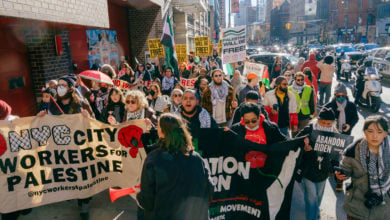Photo credit: Jerome Clarysse/Pixabay
On Dec. 10, 2022, the apartment building at 617 W. 141st St. in Harlem caught fire and burned down, leaving residents displaced ever since. The culprit? Tenants believe it was an electrical fire caused by faulty wiring related to an illegal renovation.
Allegedly, landlord Jonathan Samet was attempting to convert two rent-stabilized units into a market rate unit. This process is known as the “Frankenstein loophole,” where rent-stabilized units are combined or reconfigured into “new” units not subject to any rent regulations.
After a short stay at the Sheraton provided by the city, residents, including many elderly and non-English speakers, were thrown out onto the street with no clear plan. Relocation support and legal assistance to ensure the tenants’ safe return to their homes has been provided by local non-profit organizations, such as the Harlem-based People Against Landlord Abuse and Tenant Exploitation.
“Every tenant kind of made their own way,” said former 617 W. 141st St. resident Marisol Correa. “Some people had to get new apartments. Others are staying with family. Others are in other shelters for families with small children. But me and my son, since we’re both adults, we ended up going to a different shelter with three of our neighbors.”
Landlord mismanagement and its devastating consequences
When the five alarm fire began that night in Harlem, residents reported that none of them heard alarms in the building, only becoming aware of the situation when they smelled smoke. Residents also reported that the lack of proper maintenance in the building had likely contributed to the cause of the fire. According to Correa, “The whole issue with the fire was that the landlord was aware of the fact that the building’s had really bad electrical issues, but did nothing about it.”
This was not the only maintenance problem. Residents discovered that their super had been assigned to multiple buildings owned by Samet, overworking the super and causing him to routinely miss appointments and mishandle repairs.
Negligence has continued. Samet has been completely absent in the process of finding new housing for the displaced tenants. Despite owning at least 37 other properties in NYC, he has not provided any of the displaced tenants with housing in these other buildings.
The ‘fire loophole‘
Intentionally leaving the building in unsafe situations that could cause a fire “sounds like something that I think management would do to get rid of what basically is a building full of low-income residents who don’t speak the language, who are immigrants just trying to raise families, but don’t pay a lot of rent,” said Correa.
The “fire loophole,” is where a landlord discourages rent-stabilized tenants from returning by dragging out post-fire repairs. Landlords may even allow dangerous conditions to persist, knowing that if a fire does happen, there is a better chance of deregulating many units and/or replacing tenants once they are rebuilt. While the intent to use the “fire loophole” can be hard to prove, tenants are nonetheless fighting to hold their landlords responsible.
In the Sunset Park neighborhood of Brooklyn, tenants have filed a suit accusing their landlord of making illegal “renovations” to their apartments post-fire in an attempt to make the units unsuitable for the previous tenants.
Confronting negligence and the landlords behind it
Prior to the fire, the tenants at 617 W. 141st St. formed a tenants’ association. They forced Samet to visit the apartment for the first time in decades and hear their concerns.
They also are not alone. Tenants at another building owned by Samet, 1834 Caton Ave. in the Flatbush neighborhood of Brooklyn, have been building a campaign demanding timely repairs to their large rent-stabilized building.
PA’LANTE is working with the tenants’ association to ensure the eventual return of the residents to the building as well as with upcoming civil suits. But this process has no specific end date, and in the meantime, tenants must continue fending for themselves. This does not have to be the case. New York City has almost 90,000 vacant rent-stabilized apartments as of 2021. These apartments, which have largely been intentionally taken off the market by landlords, could house Correa, her neighbors and many others.





